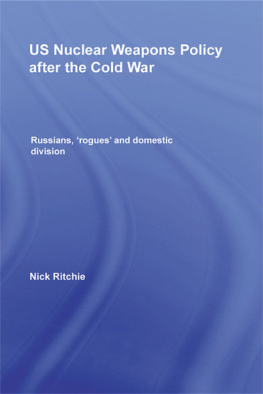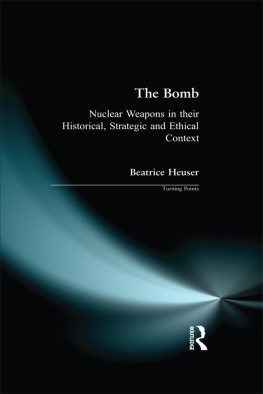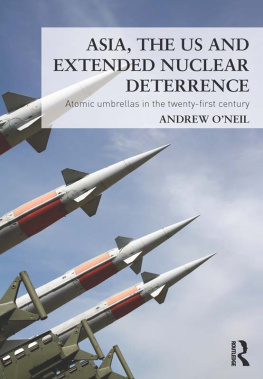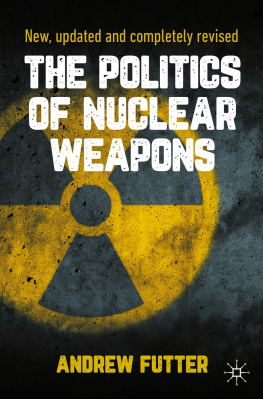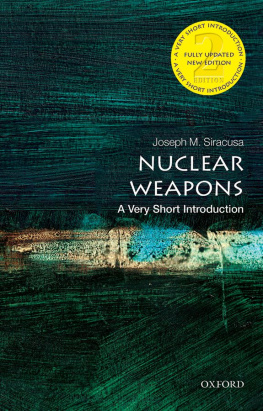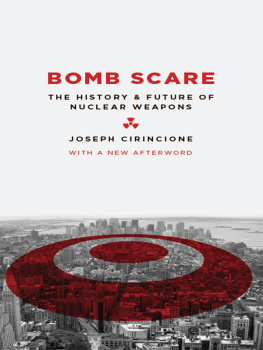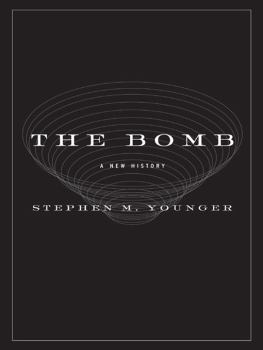
Table of Contents
First Mariner Books edition 2014
Copyright 2013 by Ward Wilson
All rights reserved
For information about permission to reproduce selections from this book, write to Permissions, Houghton Mifflin Harcourt Publishing Company, 215 Park Avenue South, New York, New York 10003.
www.hmhco.com
The Library of Congress has cataloged the print edition as follows:
Wilson, Ward.
Five myths about nuclear weapons / Ward Wilson.
p. cm.
ISBN 978-0-547-85787-9
1. Nuclear weaponsPsychological aspects.
2. Nuclear warfare. 3. Strategy. I. Title.
U264.W59 2013
355.02'17dc23 2012017322
eISBN 978-0-547-85817-3
v2.0114
This book is dedicated to the man on the train.
I am convinced that to avoid nuclear war it is not sufficient to be afraid of it. It is necessary to be afraid, but it is equally necessary to understand. And the first step in understanding is to recognize that the problem of nuclear war is basically not technical but human and historical. If we are to avoid destruction, we must first of all understand the human and historical context out of which destruction arises.
FREEMAN DYSON
Introduction
F OR NEARLY SEVENTY years, we have lived in feareven in abject terrorof nuclear weapons. These fears have changed shape and intensity depending on the world situation, but they have never disappeared. At one time, we were so worried about mutual assured destruction that schoolchildren practiced hiding under their desks, and homeowners built bomb shelters. Today, though we may be somewhat less concerned about the prospects of wiping out the human race, we still fear nuclear terrorism, nuclear proliferation, and, especially, regimes that seem to be racing to get nuclear weapons, like Irans.
Nuclear weapons seem to loom over us. We worry that we wont be able to control these dangerous weapons in a crisis. The thought of using nuclear weapons is so unpalatable that for decades we called it unthinkable. The weapons are the source of deep anxiety and concern. Yet we cant get rid of them because they areapparentlynecessary.
Fear and necessity: the two forces pull in opposite directions. It is a deeply troubling dilemma that echoes throughout the nuclear weapons debate. Consider Dr. Strangelove, a darkly comic movie from the early 1960s about a paranoid U.S. Air Force commander who, muttering strange conspiracy theories, sends his bombers to attack Russia without authorization. Despite frantic and bleakly funny efforts to recall the bombers, the movie ends with one mushroom cloud after another rising on the screen. Dr. Strangelove still works as a film even today because the actions of the air force general are believable; we can easily imagine someone being driven mad by the responsibility of planning for nuclear war.
In one sense, our concerns are justified. The possibility that nuclear weapons will get used is a clear and present danger. War has been a stubborn and consistent part of human experience for thousands of years. War may be instinctual; it may not. But it is certainly rooted in the deepest parts of human character. These sorts of deep-seated urges can overwhelm common sense. The chances that a large war will one day come and that nuclear weapons will be used if theyre available are still disconcertingly high.
Our fears about nuclear weapons have had enormous influence upon U.S. foreign policy and the foreign policies of many other nations. During the Cold War, those fears drove us to engage in an astonishingly expensive arms race; they caused panic during the Cuban missile crisis; they hovered over the proxy wars the United States fought with the Soviet Union. But even though the Cold War has ended, nuclear weapons have not released their hold on our imaginations. They played a leading role in the Bush administrations justification for invading Iraq in 2003; they led Israel to bomb an Iraqi reactor and a Syrian weapons facility; and they may yet lead to violence in Iran.
But what if our thinking about nuclear weapons is flat-out wrong? What if the assumptions that undergirded the Cold War arms race are wrong? What if our military planning and budgeting are based on faulty logic? What if, during the seven decades that have elapsed since atomic weapons were used in anger for the first and only time, we have made our choices based on beliefs that have little foundation in reality and that have been repeatedly contradicted? What if our deep-seated fears are justified, but our decades-old belief that nuclear weapons are necessary is not?
Recently there has been a noticeable shift in attitudes toward nuclear weapons. In 2007, prominent figures of the Cold Warled by George Shultz, William Perry, Henry Kissinger, and Sam Nunnproclaimed publicly that they supported the goal of a world free of nuclear weapons, and the announcement was a turning point in the U.S. debate about nuclear security. That 2007 Wall Street Journal op-ed had a transformational effect, fundamentally reconfiguring the positions within the debate on US nuclear policy for the first time in more than half a century. President Barack Obamas speech in Prague and the 2010 Nuclear Posture Review continued the shift.
In the twenty years since the end of the Cold War, new scholarship has been quietly revolutionizing the thinking about nuclear weapons. A careful review of the facts shows that the usefulness of nuclear weapons has been overblown. Inflated claims were made (and kept inflated by Cold War fears) that cannot be substantiated by the history. Much of the thinking of proponents about nuclear weapons is built on myth, misperception, exaggeration, and error. This book lays out those myths, examines the facts, and measures how far the positions of proponents have strayed from reality.
Most opponents of nuclear weapons use horror and moral outrage to make their case. They argue that humanity needs to fundamentally change its nature. But neither emotional anguish nor revolutionary change is necessary in order to imagine solutions to the problem of nuclear weapons. Pragmatic arguments that banish myths and errors with facts from the historical record are sufficient. We do not have to surrender our values, our morals, or our way of living in order to deal sensibly with nuclear weapons. Nuclear weapons are an anomaly, and we can therefore take practical steps to handle them without having to change everything.
A Four-Part Story
Knowledge comes from experience. Our ideas about nuclear weapons have grown out of our experiences with them, limited though those experiences may be. Four key experiences led people to think they understood nuclear weapons; four events coalesced into common knowledge.
This book will reexamine the story of nuclear weapons through its four parts. Call them the shock, the leap, the crisis, and the peace. Each of these four experiences led to the formation of an idea, and each of those four ideas became a foundation stone in the current conventional wisdom. Yet each of these four experiences was misunderstood and misinterpreted. Each of the four foundational ideas they led to are wrong. These errors have become enshrined in myths and have hardened into an orthodoxy that today is as brittle as old bone.
The first partthe shockcovers early decisions to pursue nuclear weapons, and its most important event is the first (and only) use of nuclear weapons in war. The bombing of Hiroshima and Nagasaki and subsequent surrender of Japan was an event that led to a crucial conclusion: nuclear weapons have a unique ability to shock and coerce an opponent.
Next page


